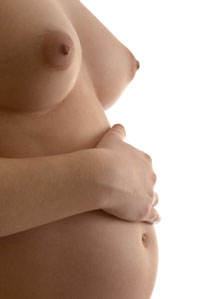 If you’re pregnant, you’re no doubt expecting big changes: your job, romance, money, sleep — all must adjust to accommodate the new little love of your life. But there are smaller changes, too, that can affect your health and feelings of well being and — I’ll say it — sexiness for years to come. Making a baby takes your body on a wild ride. Here’s what to expect for your breasts.
If you’re pregnant, you’re no doubt expecting big changes: your job, romance, money, sleep — all must adjust to accommodate the new little love of your life. But there are smaller changes, too, that can affect your health and feelings of well being and — I’ll say it — sexiness for years to come. Making a baby takes your body on a wild ride. Here’s what to expect for your breasts.
Breast friends: the early days
Some women are surprised at how much their breasts can change during pregnancy — and not just in size. According to the American Pregnancy Association, common changes include not only enlargement, but tenderness and hypersensitivity. Tenderness usually starts early, in the first four to six weeks. In fact, for many women, it can be one of the earliest signs that they are pregnant.
Hypersensitivity often begins when your breasts start growing, at about eight weeks. Around the same time, your skin will start to stretch and your breasts may start to itch. Lotion might help, but you also may find that one day all your previously comfortable lacy bras seem so unbearably scratchy that you have to make an emergency trip to the nearest bra store for something in soothing cotton. Don’t spend all your bra money now, though; you’ll need some to spend in a few months, when your breasts have grown large enough to require a new size.
As your pregnancy progresses, you’ll likely see some other common changes caused by hormones and the increased blood supply. These changes can include darkening of the nipples or areolas (the skin around your nipples) and darkened veins. Your nipples may also start to stick out more, and both your nipples and areoles will likely grow larger. Don’t be concerned if you start seeing bumps on the surface of your areolas. Those are just oil-producing glands called Montgomery’s tubercles, which are always there but may just become more pronounced.
You may also be surprised one day by the appearance of fluid leaking from your breasts. This, too, is likely normal. The fluid is probably colostrum, or “pre-milk,” a sweet, watery fluid that is easy for babies to digest and will sustain them for a few days after birth until your breast milk “comes in.” Some sources say that you won’t produce colostrum until the middle of your second trimester, while others recognize that it can happen as early as three months. If you notice what looks like dried milk on the tips of your breasts, you can use a warm, damp washcloth to gently clean it away.
How big will you get?
Experts say you can expect to grow at least a full cup size, maybe two, if this is your first child. Whether you are looking forward to this effect or not, keep in mind that you will likely need much more support than normal, even at night. You might try sleeping in a supportive cotton sports bra to decrease discomfort. You can also try a “pregnancy sleep bra,” usually made in soft “nonrestrictive” cotton and available at maternity stores.
Baby comes home
Once your baby is born, your estrogen and progesterone levels drop, causing milk production to begin. Prolactin then signals your breasts to start manufacturing. It will still take two to five days on average before your milk will be available for feeding. In the meantime, that colostrum you started making during pregnancy will sustain your baby.
Once you start regular feedings, don’t be worried if you find breastfeeding to be less than simple, or if it takes you some time to figure out. Elisabeth Squires, author of Boobs: A Guide to Your Girls, cautions that just because breastfeeding is “natural,” this doesn’t mean it will always come naturally. In fact, Squires notes that some well-meaning campaigns to encourage breastfeeding may have given the false impression that breastfeeding should be easy, causing some women to give up if they run into difficulties early on. Give yourself time, be patient and don’t be afraid to ask for help. And be aware that it can take your baby as long as six weeks to get the hang of it, too.
You may be surprised to learn that breastfeeding is not just good for your baby — it’s also good for you. When your baby latches on to the nipple and areola, your body releases the “feel good” hormone oxytocin. It is this hormone that creates the “let down” of milk. Oxytocin also helps your uterus to contract back to its pre-baby size. And the hormone is credited with helping in the “bonding” between you and your child.
Some women experience engorgement, when their breasts become too full and painful. Nursing will help, as will pumping and changing the position in which you feed. Some women experience cracked or sore nipples, which most experts say can be remedied by changing the baby’s “latch” on the breast. Blocked ducts can occur, as can mastitis, an inflammation and infection that affects about 30 percent of nursing moms and occurs when bacteria gets into your body through your breasts. If you start having a fever and flu-like symptoms, it could be mastitis, so be sure to see your doctor right away.
Finally, keep yourself well fed and hydrated. Your body is working all the time, not only to recover from birth, but also to keep producing milk. Taking care of yourself will help you take care of your baby!
Kathryn Russell Selk lives, works and is currently suffering her own pregnancy breast issues in Seattle, where she plans to give her son, Kiernan, a little brother or sister in January.
Getting great support
Bras
A good bra can minimize pain and other problems during pregnancy and nursing. Rebecca Matthais, president of A Pea in the Pod, Mimi Maternity and Motherhood Maternity, notes that regular fashion bras are not usually constructed to provide the support and comfort you will need during pregnancy and nursing. She recommends buying a maternity bra during the fourth month, making sure it fits well on the tightest hook, so you can loosen it as your body gets bigger. She also recommends getting a sleep bra for nighttime support and nursing, starting around month six. According to Matthais, you will likely need a minimum of three bras, so you will always have one available to wear.
Some maternity stores have a “fit specialist” to help you find the right bra. Nordstrom, Macy’s and other department stores usually have such specialists, too, although you may want to call ahead to make sure there will be someone there who is familiar with maternity issues.
Nordstrom has “Bra Fit Guides” at www.nordstrom.com (select “women,” then “lingerie” then “fit and measuring tips” from the bottom of the screen).
Village Maternity offers expert bra fittings. Located in the University Village Shopping Mall.
On the Macy’s site, you can watch “Bra-Solutions” videos.
Information about issues in pregnancy is available at the Web sites of all of Matthais’ stores:
A Pea in the Pod.
Breastfeeding and postpartum breast issues
What can you do if you have difficulties with breastfeeding or breast issues after your baby is born? Here are some helpful sources:
La Leche League International is a worldwide organization that provides info and support for breastfeeding mothers. The site offers online help, connections with many local groups and resources, and mother-to-mother forums.
Breast Friends is a breastfeeding awareness Web site run by medical professionals with great links to resources throughout King County, including support groups, private-practice lactation specialists, breast pump rental places and a great list of hospital-based lactation specialists.
A Snohomish County doula's site includes links to resources throughout North King, South Skagit and Snohomish counties.
The Thurston County Public Health and Social Services Department offers a list of resources in Thurston, Mason, Lewis, Pierce and Grays Harbor counties.











